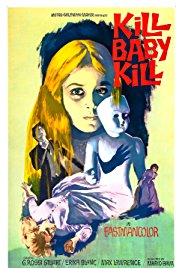 This mid-sixties creepfest is one of the most famous and influential films of Italy’s legendary Mario Bava. I don’t consider it the maestro’s best work, but do find it shivery and disquieting, with its impossible-to-forget ghostly girl with a bouncing ball, surely one of the most enduring sights in horror history.
This mid-sixties creepfest is one of the most famous and influential films of Italy’s legendary Mario Bava. I don’t consider it the maestro’s best work, but do find it shivery and disquieting, with its impossible-to-forget ghostly girl with a bouncing ball, surely one of the most enduring sights in horror history.
In retrospect KILL, BABY…KILL! (OPERAZIONE PAURA; 1966) can be viewed as a sort of bridge between Mario Bava’s stately early films (BLACK SUNDAY, BLACK SABBATH) and later exploitation quickies (THREE DOLLS FOR AN AUGUST MOON, BARON BLOOD). It looks great, with artful color photography, but, with its tacky film stock and overuse of the zoom lens, lacks the care and beauty of Bava’s finest work. Bava here, unlike in most of his other films, did not act as his own cinematographer, and it shows.
Dr. Eswai, a coroner, is called to a small Transylvanian village. There a police inspector wants Eswai to autopsy the body of a woman who fell to her death the night before. Eswai meets Monica, an attractive young lady whose scientific education makes her the only person qualified to assist him. Later that night Eswai gets into a scrap with two local punks but a mysterious woman scares the guys off…and then vanishes into thin air.
Such occurrences are standard in the town, where a creepy little girl is constantly showing up and then disappearing. Eswai spots the girl while investigating an old castle where Monica is staying; the girl appears in an upper hallway of the place, identifies herself as Melissa and then vanishes, leaving a bouncing ball and unearthly giggling in her place.
The town, it seems, is under a curse that commenced when young Melissa Graps, the girl Eswai spotted, was murdered in plain view of the townspeople, who did nothing to stop the killing. Since then over ten people have met with suspicious deaths.
Eswai attempts to warn the townspeople of the danger in their midst, but is unsuccessful. He and Monica find themselves in a family crypt underneath the accursed mansion–which Monica finds strangely familiar–where Melissa’s corpse is interred. They manage to make their way to the upper floors of the mansion, where they confront the ancient Baroness Graps, who it turns out is the mother of Melissa—and of Monica as well. There’s a dark secret the hag is about to divulge that will put an entirely new spin on all the preceding events, not to mention a surprise appearance by the ghostly woman Eswai spotted earlier, who has a troubling bond with the Baroness.
Although ahead of its time in many respects, KILL, BABY…KILL! is still very much a product of it, with distorted rippling effects used to convey dream states, much zoom lens abuse, an overwrought musical score and a clichéd old dark castle setting (an obligatory element in sixties Euro-horror). Bava’s great innovation was to combine old school gothic terrors of the type favored by his mentor Riccardo Faeda (director of classics like THE HORRIBLE DOCTOR HITCHCOCK and I, VAMPIRI) with those of the emerging Italian crime/mystery (or giallo) format, which Bava pioneered in THE GIRL WHO KNEW TOO MUCH and BLOOD AND BLACK LACE, and which is evident here in the fairly intense (for the time) gore scenes and whodunit narrative.
What resonates today is that wide-eyed girl with her bouncing ball, unearthly giggle and retinue of creepy dolls. The ghostly Melissa has remained with me, not to mention the many filmmakers who’ve recycled the image over the years—see Fellini’s “Toby Dammit” episode of SPIRITS OF THE DEAD, THE SHINING and the countless J-horror flicks that feature pasty ghost kids. All owe a substantial debt to KILL, BABY…KILL!
Vital Statistics
KILL, BABY…KILL! (OPERAZIONE PAURA) FUL Films
Director: Mario Bava
Producers: Nando Pisani, Luciano Catenacci
Screenplay: Romano Migliorini, Roberto Natale, Mario Bava
Cinematography: Antonio Rinaldi
Editing: Romana Fortini
Cast: Erica Blanc, Giacomo Rossi-Stuart, Fabienne Dali, Giana Vivaldi, Piero Lulli, Max Lawrence, Micaela Esdra, Franca Dominici, Giuseppe Addobbati, Mirilla Ranfli, Valerio Valeri
